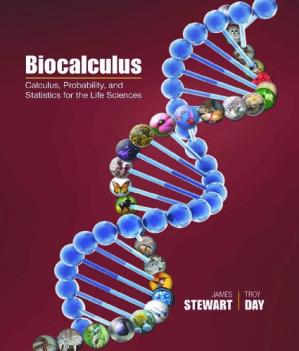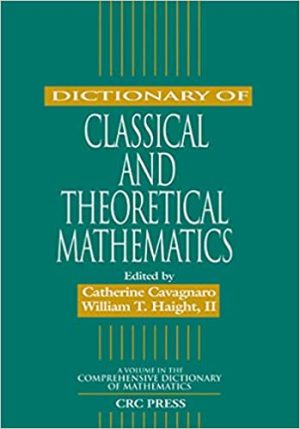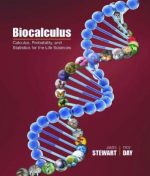Biocalculus: Calculus, Probability, and Statistics for the Life Sciences by James Stewart, ISBN-13: 978-1305114036
[PDF eBook eTextbook]
- Publisher: Cengage Learning; 1st edition (July 22, 2015)
- Language: English
- 1032 pages
- ISBN-10: 1305114035
- ISBN-13: 978-1305114036
BIOCALCULUS: CALCULUS, PROBABILITY, AND STATISTICS FOR THE LIFE SCIENCES shows students how calculus relates to biology, with a style that maintains rigor without being overly formal. The text motivates and illustrates the topics of calculus with examples drawn from many areas of biology, including genetics, biomechanics, medicine, pharmacology, physiology, ecology, epidemiology, and evolution, to name a few. Particular attention has been paid to ensuring that all applications of the mathematics are genuine, and references to the primary biological literature for many of these has been provided so that students and instructors can explore the applications in greater depth. Although the focus is on the interface between mathematics and the life sciences, the logical structure of the book is motivated by the mathematical material. Students will come away with a sound knowledge of mathematics, an understanding of the importance of mathematical arguments, and a clear understanding of how these mathematical concepts and techniques are central in the life sciences.
Table of Contents:
PROLOGUE: MATHEMATICS AND BIOLOGY. CASE STUDIES. Case Study
1: Kill curves and antibiotic effectiveness. Case Study
2: Hosts, parasites, and time travel. Chapter 1 Functions and Sequences. 1.1 Four Ways to Represent a Function. 1.2 A Catalog of Essential Functions. 1.3 New Functions from Old Functions. Project: The Biomechanics of Human Movement. 1.4 Exponential Functions. 1.5 Logarithms; Semi-log and Log-log Plots. Project: The Coding Function of DNA. 1.6 Sequences and Difference Equations. Project: Drug Resistance in Malaria. Review. Case Study 1a: Kill curves and antibiotic effectiveness. Chapter 2 Limits. 2.1 Limits of Sequences. Project: Modeling the Dynamics of Viral Infections. 2.2 Limits of Functions at Infinity. 2.3 Limits of Functions at Finite Numbers. 2.4 Limits: Algebraic Methods. 2.5 Continuity. Review. Case Study 2a: Hosts, parasites, and time travel. Chapter 3 Derivatives. 3.1 Derivatives and Rates of Change. 3.2 The Derivative as a Function. 3.3 Basic Differentiation Formulas. 3.4 The Product and Quotient Rules. 3.5 The Chain Rule. 3.6 Exponential Growth and Decay. Project: Controlling Red Blood Cell Loss During Surgery. 3.7 Derivatives of the Logarithmic and Inverse Tangent Functions. 3.8 Linear Approximations and Taylor Polynomials. Project: Harvesting Renewable Resources. Review. Case Study 1b: Kill curves and antibiotic effectiveness. Chapter 4 Applications of Derivatives. 4.1 Maximum and Minimum Values. Project: The Calculus of Rainbows. 4.2 How Derivatives Affect the Shape of a Graph. 4.3 L’Hopital’s Rule: Comparing Rates of Growth. Project: Mutation-Selection Balance in Genetic Diseases. 4.4 Optimization. Project: Flapping and Gliding. Project: The Tragedy of the Commons: An Introduction to Game Theory. 4.5 Recursions: Equilibria and Stability. 4.6 Antiderivatives. Review. Chapter 5 Integrals. 5.1 Areas, Distances, and Pathogenesis. 5.2 The Definite Integral. 5.3 The Fundamental Theorem of Calculus. Project: The Outbreak Size of an Infectious Disease. 5.4 The Substitution Rule. 5.5 Integration by Parts. 5.6 Partial Fractions. 5.7 Integration Using Tables and Computer Algebra Systems. 5.8 Improper Integrals. Project: Drug Bioavailability. Review. Case Study 1c: Kill curves and antibiotic effectiveness. Chapter 6 Applications of Integrals. 6.1 Areas Between Curves. Project: Disease Progression and Immunity. Project: The Gini Index. 6.2 Average Values. 6.3 Further Applications to Biology. 6.4 Volumes. Review. Case Study 1d: Kill curves and antibiotic effectiveness. Case Study 2b: Hosts, parasites, and time travel. Chapter 7 Differential Equations. 7.1 Modeling with Differential Equations. Project: Chaotic Blowflies and the Dynamics of Populations. 7.2 Phase Plots, Equilibria, and Stability. Project: Catastrophic Population Collapse: An Introduction to Bifurcation Theory. 7.3 Direction Fields and Euler’s Method. 7.4 Separable Equations. Project: Why Does Urea Concentration Rebound After Dialysis? 7.5 Systems of Differential Equations. Project: The Flight Path of Hunting Raptors. 7.6 Phase Plane Analysis. Project: Determining the Critical Vaccination Coverage. Review. Case Study 2c: Hosts, parasites, and time travel. Chapter 8 Vectors and Matrix Models. 8.1 Coordinate Systems. 8.2 Vectors. 8.3 The Dot Product. Project: Microarray Analysis of Genome Expression. Project: Vaccine Escape. 8.4 Matrix Algebra. 8.5 Matrices and the Dynamics of Vectors. 8.6 The Inverse and Determinant of a Matrix. Project: Cubic Splines. 8.7 Eigenvalues and Eigenvectors. 8.8 Iterated Linear Transformations. Project: The Emergence of Geometric Order in Proliferating Cells. Review. Chapter 9 Multivariable Calculus. 9.1 Functions of Several Variables. 9.2 Partial Derivatives. 9.3 Tangent Planes and Linear Approximations. 9.4 The Chain Rule. 9.5 Directional Derivatives and the Gradient Vector. 9.6 Maximum and Minimum Values. Review. Chapter 10 Systems of Linear Differential Equations. 10.1 Qualitative Analysis of Linear Systems. 10.2 Solving Linear Systems of Differential Equations. 10.3 Applications. Project: Pharmacokinetics of Antimicrobial Dosing 10.4 Systems of Nonlinear Differential Equations. Review. Case Study 2d: Hosts, parasites, and time travel. Chapter 11 Descriptive Statistics. 11.1 Numerical Descriptions of Data. 11.2 Graphical Descriptions of Data. 11.3 Relationships Between Variables. 11.4 Populations, Samples, and Inference. Review. Chapter 12 Probability. 12.1 Principles of Counting. 12.2 What is Probability? 12.3 Conditional Probability. Project: Testing for Rare Diseases. 12.4 Discrete Random Variables. Project: DNA Supercoiling. Project: The Probability of an Avian Influenza Pandemic in Humans. 12.5 Continuous Random Variables. Review. Chapter 13 Inferential Statistics. 13.1 The Sampling Distribution. 13.2 Confidence Intervals. 13.3 Hypothesis Testing. 13.4 Contingency Table Analysis. Review. Appendixes. A Intervals, Inequalities, and Absolute Values. B Coordinate Geometry. C Trigonometry. D Precise Definitions of Limits. E A Few Proofs. F Sigma Notation. G Complex Numbers. H Statistical Tables. I Glossary of Biological Terms. J Answers to Odd-Numbered Exercises. List of Biological Applications. Index.
The late James Stewart received his M.S. from Stanford University and his Ph.D. from the University of Toronto. He conducted research at the University of London and was influenced by the famous mathematician George Polya at Stanford University. Dr. Stewart most recently served as a professor of mathematics at McMaster University, and his research focused on harmonic analysis. Dr. Stewart authored a best-selling calculus textbook series, including CALCULUS, CALCULUS: EARLY TRANSCENDENTALS and CALCULUS: CONCEPTS AND CONTEXTS as well as a series of successful precalculus texts.
Troy Day received his M.S. in biology from the University of British Columbia and his Ph.D. in mathematics from Queen’s University. His first academic position was at the University of Toronto, before being recruited back to Queen’s University as a Canada Research Chair in Mathematical Biology. He is currently a Professor of Mathematics and Statistics and a Professor of Biology. His research group works in areas ranging from applied mathematics to experimental biology. Troy Day is also coauthor of the widely used book A BIOLOGIST’S GUIDE TO MATHEMATICAL MODELING, drafted by Princeton University Press in 2007.
What makes us different?
• Instant Download
• Always Competitive Pricing
• 100% Privacy
• FREE Sample Available
• 24-7 LIVE Customer Support









Reviews
There are no reviews yet.